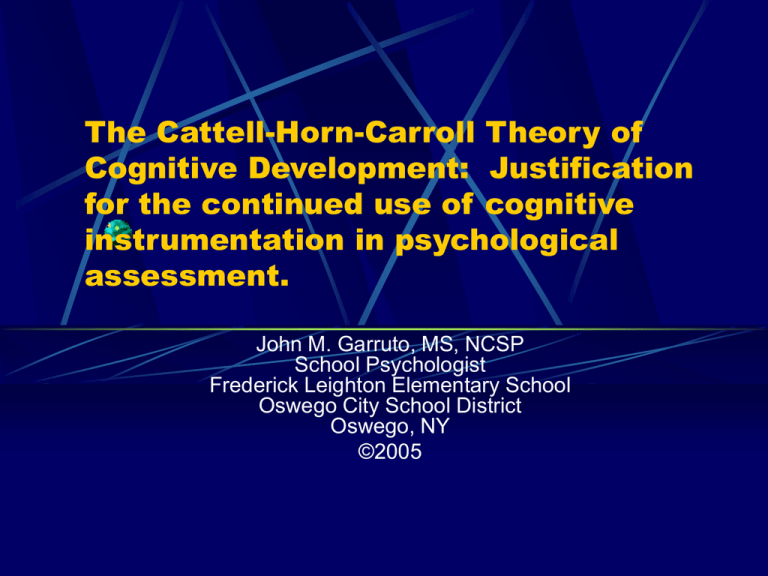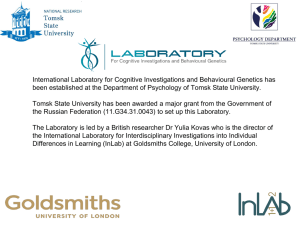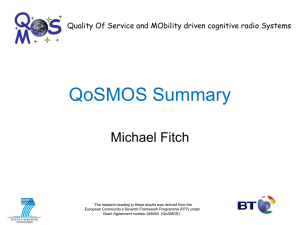The Cattell-Horn-Carroll Theory of Cognitive Development: A
advertisement

The Cattell-Horn-Carroll Theory of Cognitive Development: Justification for the continued use of cognitive instrumentation in psychological assessment. John M. Garruto, MS, NCSP School Psychologist Frederick Leighton Elementary School Oswego City School District Oswego, NY ©2005 It is Meanwhile, age of there controversy are a few between rebel school the cognitive psychologists processing who believe Try to the picture the previous text boxes leaving the screen factions, that best practice the RTI factions, can be instituted and the traditional by combining assessment both thefactions. RTI through the top. After a silent paradigm andcold the cognitive war between processing all theorists, paradigm. the federal Can these government few has come school psychologists out with a law stand that tall clearly against favors overwhelming the RTI faction. odds toThe provide traditional best practice factions for their andclients? the cognitive processing factions have been silently accepting, yet planning how their paradigms can be pushed through, despite discouragement from these paradigms by the federal law. IDEA WARS By the end of this presentation, you should be able to: Identify the limitations of the cognitive-achievement discrepancy approach to learning disability evaluations. Discuss the promise and the pitfalls to the uses of informal assessment when working with students who have learning concerns. Discuss how the Cattell-Horn-Carroll (CHC) theory and cross battery assessment fit into a problem solving model for identifying learning disabilities and for intervention for students with various learning concerns. The traditional approach to learning disability identification Historically, eligibility for learning disabilities was determined by use of a discrepancy model. Although how this was determined varied from practitioner to practitioner, although one of these methods were often used: Use of Normal Curve Equivalents Simple-Difference Method Predicted-Achievement Method Use of Normal Curve Equivalents Pros: Allowed practitioner to find a 50% discrepancy between cognitive and achievement. Easy method to use (divide NCE of cognitive score by two-scored below NCE on achievement measure considered discrepant.) Cons: Assumes a 1:1 relationship between cognitive and achievement measures. Easier to identify lower functioning students, harder to identify higher functioning students (cognitively). See Mark Penalty Use of the simple-difference method: Pros: Established statistics for determining statistical significance. Easy to use (subtract cognitive from achievement and find corresponding alpha level.) Cons: Does not take into account natural regression to the mean. Alpha levels are misunderstood-they indicate the likelihood that the difference is not due to chance, not how prevalent the difference is in the population. See Mark Penalty Use of the predicted achievement method Pros: Uses regression to the mean as a way to predict individual achievement. Cons: If you do not use data in the manual, you must know how to predict achievement. See Mark Penalty So what is this Mark Penalty? The Mark Penalty: “**Mark 4:25: "For he that hath, to him shall be given: and he that hath not, from him shall be taken even that which he hath." The Mark Penalty is incurred when a student's disability (e.g., visual impairment, hearing loss, or learning disability basic process disorder) is allowed to depress not only measures of academic achievement, but also estimates of the student's intelligence so that the misguided examiner or benighted team concludes that there is no significant difference between the student's academic achievement and the level of achievement that would be predicted from the student's score on the intelligence test. The same disability is depressing both the student's actual achievement and the erroneous estimate of the student's intellectual ability.” Taken from the webpage-Dumont-Willis http://http://alpha.fdu.edu/psychology/FLOW_CHART.htm As can be seen in the quote below from IDEA1997, such a practice is NOT LEGAL. Taken from 34 C.F. R. § 300.532. Evaluation procedures: Tests are selected and administered so as best to ensure that if a test is administered to a child with impaired sensory, manual, or speaking skills, the test results accurately reflect the child’s aptitude or achievement level or whatever other factors the tst purporst to measure, rather than reflecting the child’s impaired sensory, manual, or speaking skills (unless those skills are the factors the test purports to measure). Taken from http://framework.esc18.net/documents/34CFR300/500/300.5 32.htm In addition to the preceding factors, the traditional approach does not necessarily link assessment to intervention. It is primarily focused on eligibility. Such a conceptualization can be problematic because it focuses on scores, not necessarily on processes. A discrepancy itself does not highlight a disorder in one or more of the basic psychological processes. Recap on traditional assessment Normal curve equivalents, the simple-difference method, and predicted achievement method, are some ways of establishing a discrepancy. No approach takes into account the “Mark Penalty” and are contrary to § 300.532 “Evaluation Procedures” of the C.F.R. Assessments may be focused on eligibility only and not on the intervention planning process. The Response to Intervention model has been indicated as an option by the 2005 Reauthorization of Individuals with Disabilities Education Act to circumvent the problems identified with the traditional approach. The theme of this approach is that special education should be the last area that is visited-that the student cannot receive a Free and Appropriate Public Education without special educations upports. Characteristics of the Response to Intervention paradigm Decreased emphasis on norm-referenced or individualized assessment (may not translate to what is happening in the classroom) Increased opportunities for indirect intervention (consultation) Increased opportunities for direct intervention (counseling) Increased use of alternative local assessments (such as DIBELS, curriculum based assessments, or curriculum based measurement.) Positive points to this paradigm Progress monitoring is easier (can administer multiple assessments and document quality of interventions). Onus is on using empirically based interventions, not minor informal changes. Student can be compared to peers in their local cohort, as opposed to a national representation. Are there cons to this framework? YES! Assessments are outcome-driven, not process driven (You only see the products as a result of cognitive processes.) More difficult to determine to what extent facilitators and inhibitors end and real learning problems begin. Difficult to determine etiology of the referral concern. Recap on response to intervention: Decrease emphasis on normed assessment. Increased opportunities for other school psychologist roles. Can monitor progress by administering multiple assessments. Results focus on outcomes, not process. Difficult to determine disorder in basic psychological processes-assumption is made of LD. The multi-tiered model advocates a comprehensive implementation of the problem solving model. However, few writings on utilizing a response to intervention framework give suggestions about alternatives to the “referral” stage. Specific theoretical models are not endorsed. There are problems with this framework. Consider: •If the definition of learning disabled is still a disorder in one or more of the basic psychological processes, how will these deficits be defined if we go right to identification without formal assessment? •Will there be a temptation to use the traditional approach at the final tier, an approach that we already know is problematic? This is why a solid theoretical approach is endorsed. An approach that fits this model is… The Cattell-Horn Carroll (CHC) Theory of Cognitive Development The Cattell-Horn-Carroll Theory of cognitive development is a synthesis of the models by Raymond Cattell, John Horn, and John Carroll. Cattell postulated that there were two overall abilities people have: Crystallized intelligence and fluid intelligence. Crystallized intelligence reflected abilities that were relatively static (such as learned information) while fluid intelligence was more related to novel problem solving. John Horn expanded this model by adding seven to nine (depending on your theoretical orientation) broad abilities. They include: John Horn’s broad abilities Crystallized Intelligence (Gc) Fluid Reasoning (Gf) Auditory Processing (Ga) Processing Speed (Gs) Visual-Spatial Processing (Gv) Short-Term Memory (Gsm) Reading/ Writing ability (Grw) Long-Term Retrieval (Glr) Quantitative Reasoning (Gq) After analyzing past years of data, John Carroll came up with his own se of broad abilities. He also offered a three-stratum theory of cognitive development. •Stratum III represents ‘g’ or overall intelligence. •Stratum II represents the broad abilities previously discussed. •Stratum I represents the narrow abilities grouped under the broad abilities (for example, the broad construct of Gsm includes the narrow abilities of working memory and memory span.) John Horn and John Carroll agreed to synthesize their theories (Carroll’s three stratum theory with Horn’s broad abilities). The result is the CHC theory of cognitive development. Following the evolution of CHC theory, cross battery assessment emerged as a way to assess students. The principle is to select tests from varied batteries which best match the referral concern. The examiner then puts the scores into a cross-battery template, where the stratum II and I levels are aggregated (the subtests were matched with their stratum I and II counterparts by an expert consensus study.) Those scores are then averaged. Although combining subtests and averaging may not seem like best practice, it has been noted to be an empirically defensible practice (See the FAQ section in http://www.crossbattery.com) Why cross battery assessment? Why not just give the whole WJ-III? Assessments should be based on the referral concern. The WJ-III is a good test, but other tests measure other constructs better (for example, WISC-IV is a great measure of Gc, but has no measures of Ga or Glr). Highlighting cognitive profiles, as opposed to broad ability composites can better reflect a child’s strengths and weaknesses. Why bother with this theory of assessment if the problem solving literature is not strongly linking assessment with intervention? The research DOES link cognitive constructs with academic deficiencies. A thorough assessment of cognitive abilities can be helpful in terms of determining to what extent other facilitators and inhibitors may be hindering progress of students (e.g. attention and focus, motivation, ecological factors (instruction)). Why bother with this theory of assessment if the problem solving literature is not strongly linking assessment with intervention? (Part Deux) Consider the problem solving model. Accurately identifying the problem is important. Think of functional behavioral assessments-it is the hypothesis that is the crux of the FBA (which fits into the problem solving model.) School psychologists are experts at understanding information processing. Individualized assessment can confirm those “disorders in the basic psychological processes.” In addition to the preceding justifications for cognitive assessment, consider this quote by Hale and Fiorello (2004) on aptitude-treatment interactions: Because most ATI research occurred when investigators had poor assessment instruments and a limited understanding of brain functions, early AT research failures have been attributed to a variety of reasons. Many cognitive constructs were poorly defined or poorly measured (Ysseldyke & Salvia, 1974). Often, heterogeneous groups were simply divided at the median to define “high” and “low” groups. Treatments were poorly defined or implemented without integrity checks (Reynolds, 1988). (p. 40) Hale and Fiorello then go on to say: As Branden and Kratochwill (1997) have noted, however the fact that ATIs weren’t established in the past doesn’t mean that they can’t be established in the future, especially at the single-subject level of analysis. Changing the focus from the content of test items (e.g., auditory, visual) to the underlying psychological processes (Reynolds, Kamphaus, Rosenthal, & Hiemenz, 1997) may be key to understanding the true nature of brain-behavior relationships for individual children. (p. 40) Not convinced? Just kidding In a case study noted in Hale and Fiorello (2005), they reflect on a child who was identified as learning disabled in the second grade. Only anecdotal reports were used at reevaluation and he was subsequently brought in for a private evaluation. The clinician noticed a decline in overall functioning and that his profile had been markedly different. After a subsequent referral to a neurologist, it was found out that the child had a brain tumor. (p.21) Someone already did this PowerPoint? Two days before presenting this PowerPoint, I had discovered that someone did a very similar presentation at NASP. Jim Hanson (2005) of Portland public schools spoke of synthesizing the two models. Here is something from his presentation that is noteworthy: Cognitive Processing Is it ethical NOT to use available technology that better addresses instructional variables, results in earlier service delivery, and might improve outcomes for students? RTI Is it ethical to CLASSIFY a student as having a specific learning disability on the “assumption” or “inference” that a child has a “withinchild” neurological difference? Why use CHC as part of the Problem Solving Model? It is an empirically based theory, solidified through comprehensive research of previous evaluations. The cognitive constructs HAVE been related to certain academic difficulties. It allows for confirmation of a disorder in one or more of the psychological processes. The research suggests there are still possibilities for linking assessment with intervention. Implications for practitioners and training programs: Promoting an RTI paradigm in schools pushes us to put the focus on intervention, not diagnosis or problem admiration. Using a solid theoretical base for cognitive assessment is justified as part of the continuum for a problem solving model in identifying learning disabilities. Thank you for coming, participating, and putting up with my pop-culture addiction! References DDeno, S. L. (2003). Problem Solving as "Best Practice". Best Practices in School Psychology IV. A. Thomas and J. Grimes. Bethesda, Nationa Association of School Psychologists. 1: 37-55. DDumont, R.P. & Willis, J.O. (2001). CHC Theory. Retrieved July 5, 2005, from http://alpha.fdu.edu/psychology/chc_theory.htm. EElliot, C.D. (1990). Differential Ability Scales. San Antonio, TX: The Psychological Corporation. EEvans, J. J., R. G. Floyd, et al. (2002). "The Relations Between Measures of Cattell-Horn-Carroll (CHC) Cognitive Abilities and Reading Achievement During Childhood and Adolescence." School Psychology Review 31(2): 246-263. FFlanagan, D. P. (2000). "Improving the validity of test interpretation through Wechsler-based Gf-Gc cross-battery assessment." NYS Psychologist 12(1): 38-42. FFlanagan, D. P. and S. O. Ortiz (2003). Best Practices in Intellectual Assessment: Future Directions. Best Practices in School Psychology IV. A Thomas and J. Grimes. Bethesda, National Association of School Psychologists. 2: 1351-1372. FFlanagan, D. P., S. O. Ortiz, et al. (2002). The Achievement Test Desk Reference. Boston, Allyn & Bacon. FLloyd, R. G. (2003). "Relations Between Measures of Cattell-Horn-Carroll (CHC Cognitive Abilities and Mathematics Achievement Across th School-Age Years." Psychology in the Schools 40(2): 155-172. HHale, J. B. and C. A. Fiorello (2004). School Neuropsychology: A Practitioner's Handbook. New York, The Guilford Press. McGrew, K. and D. P. Flanagan (1997). "Beyond g: The impact of Gf-Gc specific cognitive abilities research on the future use and interpretatio of intelligence tests in the schools." School Psychology Review 26(2): 189-201. RReschly, D. J. and J. P. Grimes (2003). Best Practices in Intellectual Assessment. Best Practices in School Psychology IV. A. Thomas and J Grimes. Bethesda, National Association of School Psychologists. 2: 1337-1350. RReschly, D. J. and J. E. Ysseldyke (2003). Paradigm Shift: The Past is Not the Future. Best Practices in School Psychology IV. A. Thomas and Grimes. Bethesda, National Association of School Psychologists. 1: 3-20. SSattler, J.M. (2001). Assessment of Children: Cognitive Applications. San Diego, CA: Author. TTilly, W. D. (2003). Best Practices in School Psychology as a Problem-Solving Enterprise. Best Practices in School Psychology IV. A. Thomas and J. Grimes. Bethesda, National Association of School Psychologists. 1: 21-36. UUnited States Department of Education Office of Special Education and Rehabilitative Services (2005). Proposed Rules. Retrieved July 5, 20 from http://www.nasponline.org/advocacy/05-11804.pdf WWagner, R.K., Torgensen, J.K., & Rashotte, C.A. (1999). Comprehensive Test of Phonological Processing. Austin, TX: PRO-ED. WWillis, J. O. & Dumont, R. P. (1998). Guide to Identification of Learning Disabilities (1998 New York State Ed., p. 104). Acton, MA: Copley aWatkins, M.W., Kush, J.C., & Glutting, J.J. (1998). Discriminant and predictive validity of the WISC-III ACID profile among children with learning disabilities. Psychology in the Schools, 34(4), 309-319.






